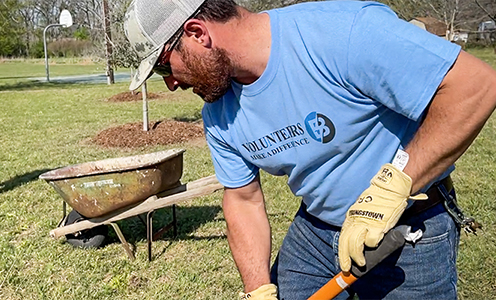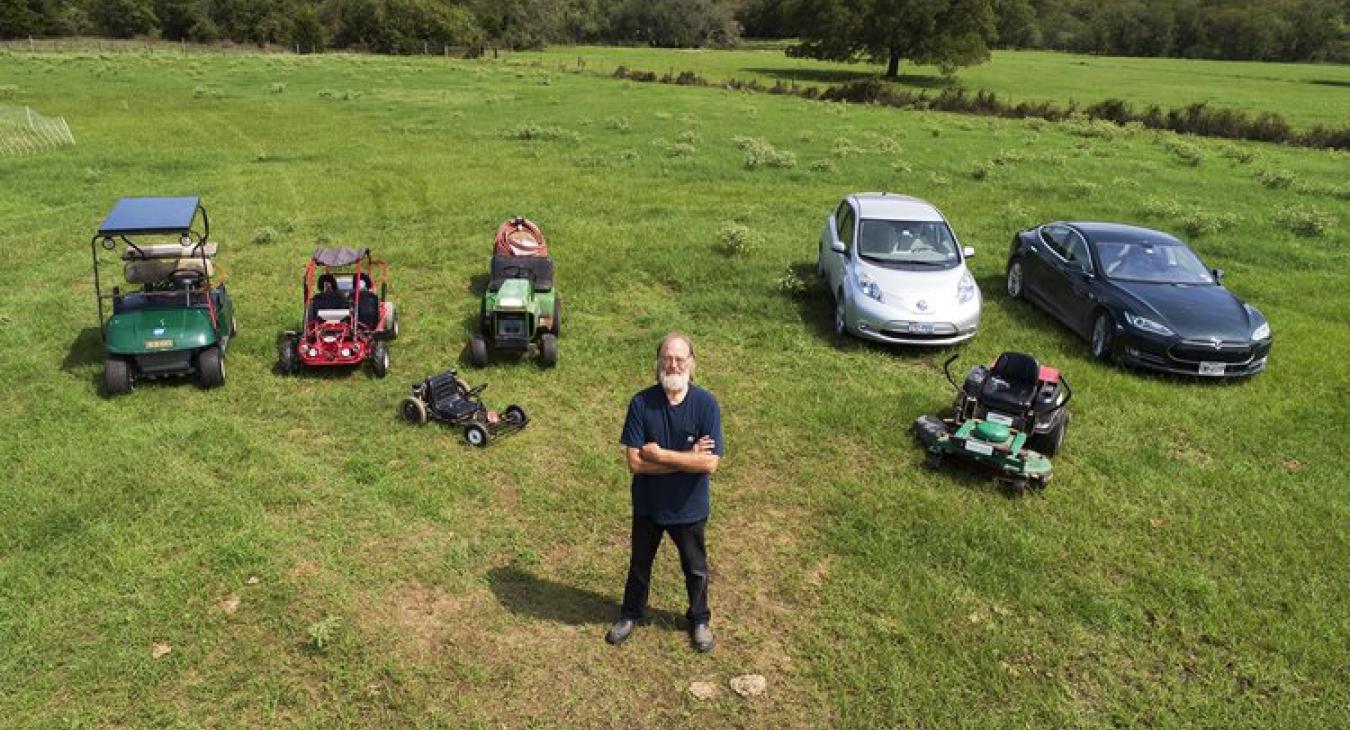Scott Little has an extensive collection of electric vehicles, some of which he’s converted to electric himself. The collection includes a golf cart, dune buggy, go-kart, fire wagon, riding lawn mower, Nissan Leaf and Tesla Model S.
STORY BY ED CROWELL
PHOTOS BY ZACH RYALL
Scott Little, a physicist and farmer, could drive his Tesla S sedan. Stephanie Little could follow in her Toyota Prius hybrid or their older Nissan Leaf. Other family members could drive the couple’s three golf carts, riding mower, dune buggy, small fire wagon with a water tank and itty-bitty go-kart.
Scott converted the mower, buggy, fire wagon and go-kart from gasoline engines to battery power in his tool-filled garage. He keeps all the vehicles charged for work and play on the couple’s 90-acre farm.
Vehicles are not the only electric-power items on the farm. Five electrically activated gates provide access to the couple’s pastures and fields. Solar panels atop the large carport produce enough power to charge all the vehicles.
Scott Little’s show of electrical force is a natural outgrowth of his professional life and his semi-retirement puttering.
“Instead of drilling Alaskan oil fields, we need to be spending our time and energy supporting alternative energy technology,” he said. “My solar panels generate as much energy as my Tesla uses, so in effect I’m driving around free, energy-wise.”
He estimates that without the solar power the cost of electricity for his Tesla “fill-up” would be about $10.
With a physics degree from the University of Texas, Scott Little worked in Austin for several scientific instrumentation firms. Then he turned to exploring new sources of energy and rocket propulsion with Austin-based EarthTech International, a privately funded research organization. He still “dabbles” in some physics experiments for EarthTech on the property the couple bought 10 years ago, he said.
SLOWLY TRENDING
The Littles aren’t the only ones sold on electric vehicles in Bluebonnet Electric Cooperative’s service area, but they are the vanguard. All-electric vehicles and the necessary public-charging stations to keep them going on lengthy road trips are slowly gaining traction in Bluebonnet’s area. However, the numbers are still tiny compared with gasoline- and diesel-powered cars, SUVs, pickups, tractors, mowers and large trucks.
In several counties that Bluebonnet serves — Bastrop, Caldwell, Burleson, Lee and Washington — only 53 all-electric cars were registered as of early October. Bluebonnet also serves parts of Travis and Williamson counties, which have large urban populations, more commuters and 5,313 registered electric vehicles.
THE RIGHT FIT
The Littles first tried an electric vehicle in 2011 when they bought a Nissan Leaf. Scott then decided to buy a Tesla in 2013 on a visit to Phoenix. “I was at a random mall and I stepped through a random entrance and there right in front of me was a Tesla showroom. It was like a moth to a flame, and a couple of months later I had one delivered to me.” Scott, who is 6-foot-9, said, “A game changer for me was when I first sat in the showroom car and I fit.”
Some of the Littles’ electric vehicles make handy farm equipment. Organic vegetables are grown on the farm, which includes dairy goats, chickens, horses and a donkey. The electric carts carry hay, feed and the picked vegetables as Scott and Stephanie move around their fields, pastures and pens.
The Littles donate most of their vegetables to the Bastrop County Emergency Food Pantry.
The couple have five grandchildren who visit often. The electric carts and buggy allow them to roam the property.
Scott’s Tesla is sometimes dusty from drives along country roads. He said it is a “marvelous hot rod” that can almost silently accelerate from 0 to 60 mph in 4.5 seconds, something he was proud to demonstrate. The four-door sedan has plenty of storage room with a front trunk space under the hood and a trunk in the back. The car is powered by 7,000 batteries, each about 3 inches long. They are spread across the entire floor of the chassis.
Scott remains a fan of the Tesla company and hopes its recent highly publicized management issues won’t get in the way of producing new electric vehicles. He’s optimistic about Tesla’s foray into short-haul trucks with the company’s initial order of 40 city delivery trucks for Budweiser in 2019. Development of long-distance electric highway trucks is a bigger hurdle because travel would put a constant draw on the batteries’ charge, he said. With start-and-stop city driving, braking produces regenerative power to keep the batteries charged.
Scott’s five-year ownership of the Tesla leads him to believe that, “I’ll never have to replace the batteries. They still have a wonderful 96 percent of their charging power after 75,000 miles. We didn’t fare so well with the Leaf. It has 38,000 miles, but the batteries had to be replaced while still under warranty.”
He recharges the cars in his garage on a 240-volt circuit he installed. The Leaf has just a 90-mile range, so it barely can go to Austin and back to Dale on one charge, he said. New models of the Leaf have a range of 151 miles. His Tesla has a 255-mile range that makes longer trips easier. The Littles traveled to Nacogdoches (460 miles round trip) with an overnight charge where they stayed and another charge in Huntsville. “It’s pleasant to get out of the car on a long trip for half an hour of charging,” Scott Little said.
See Scott Little talk about his passion in this video.





